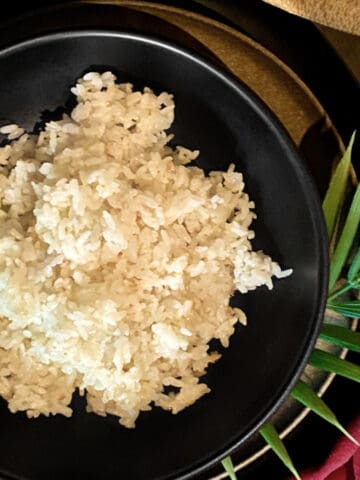Filipino Pork Adobo is a national dish of the Philippines that never fails to captivate taste buds with its irresistible flavors. This beloved Filipino delicacy is a harmonious combination of tender pork simmered in a delightful blend of soy sauce, vinegar, garlic, and aromatic spices. With every bite, you'll experience a delightful balance of savory and tangy notes beautifully infused into the meat.
And if you love the flavors of Adobo, revealing the marinade's richness while the flavors' boldness leaves you craving more, be sure to check out my recipe for Chicken Adobo. It's a 20-minute recipe using an Instant Pot.
Jump to:
What Is Filipino Adobo
Pork Adobo is a popular Filipino dish made with pork marinated in vinegar, soy sauce, garlic, bay leaves, and black peppercorns, then simmered until tender.
And if you want to know the secret to making the best Filipino Pork Adobo? Garlic. Lots of GARLIC!!! You need to marinate and simmer the pork with lots of garlic.
Simple Ingredients
Filipino pork adobo is a popular dish known for its flavorful and tangy taste. The choice of these specific ingredients contributes to the unique and delicious flavors that make this dish iconic. Let's take a closer look at each ingredient:
- Pork Belly: This is perfect for adobo as it becomes tender and absorbs the flavors of the sauce during cooking.
- Regular soy sauce: If you prefer a less salty flavor, substitute low-sodium soy sauce or tamari. For a gluten-free option, use coconut aminos.
- Vinegar: Vinegar provides a tangy, sour taste that balances the richness of the pork and soy sauce. It also helps tenderize the meat. My favorite brand of white vinegar I use is Datu Puti Vinegar.
- Garlic: Garlic is a staple ingredient in Filipino cuisine. It adds a fragrant and aromatic flavor to the dish.
- Bay Leaves: These leaves add a subtle earthy flavor and fragrance to adobo. They enhance the overall aroma of the dish.
- Black Whole Peppercorns: Peppercorns provide a hint of spiciness and a mild heat to the adobo. They also add a layer of complexity to the flavors.
- Water: Water is used to dilute the sauce slightly, allowing the meat to absorb the flavors more effectively during the simmering process.
Combining these ingredients will create a mouthwatering Filipino pork adobo rich in flavors and irresistible to your taste buds. Enjoy!
See the recipe card for exact quantities to make Filipino pork adobo.
Instructions
Filipino Pork Adobo is a classic and flavorful dish that is enjoyed by many. It's a perfect blend of tender pork, soy sauce, vinegar, garlic, and spices. Follow these simple steps to create your own mouthwatering Adobo:
- In a large bowl, marinate the pork belly with soy sauce, vinegar, minced garlic, bay leaves, and black peppercorns. Let it marinate for at least 30 minutes to allow the flavors to penetrate the meat.
- Heat a large pan or pot over medium-high heat. Add cooking oil and sauté the marinated pork until browned and slightly caramelized.
- Once the pork is browned, pour the marinade mixture over the pork in the pot. Add water and bring it to a boil.
- Reduce the heat to low and simmer for 1 to 1.5 hours or until the pork is tender. Stir occasionally to prevent sticking and ensure even cooking.
- Once the pork is fork tender and the sauce has thickened, taste and adjust the seasoning according to your preference. You can add more soy sauce or vinegar if desired.
- Remove the bay leaves and serve the Filipino Pork Adobo hot with steamed white rice. For added freshness, garnish with chopped green onions or cilantro.
Note: Filipino Pork Adobo tastes even better when left to marinate overnight in the refrigerator. The longer the marinating time, the more flavorful the dish will be.
Substitutions
If you're looking to make substitutions for Filipino Pork Adobo, here are a few options you can consider:
- Meat: Instead of pork belly, you can use other pork pieces like pork shoulder, pork ribs, pork loin, pork chops, pork tenderloin, or pork butt. Other types of meat also include chicken, beef, or even tofu as a vegetarian option. Adjust the cooking time accordingly based on the protein you choose.
- Soy Sauce: You can substitute low-sodium soy sauce or tamari if you prefer a less salty flavor. For a gluten-free option, you can use coconut aminos.
- Vinegar: While white vinegar is commonly used in adobo, you can experiment with other types of vinegar, such as apple cider vinegar, rice vinegar, cane vinegar, coconut vinegar, or even balsamic vinegar, for a unique twist.
- Garlic Cloves: Garlic is a key ingredient in adobo, but if you're not a fan or have an allergy, you can substitute it with garlic powder or minced shallots for a milder flavor.
- Bay Leaves: You can substitute dried oregano or thyme if you don't have bay leaves. They will add a different flavor profile to the adobo.
- Black peppercorns: For a slightly different level of heat, substitute black peppercorns with crushed red pepper flakes or ground black pepper.
Remember that these substitutions may alter the dish's flavor profile, so it's important to taste and adjust the seasonings according to your preference as you cook. Enjoy experimenting with different variations of Filipino Adobo!
Variations
There are various ways to tweak the classic Filipino pork adobo recipe to create delicious variations. Here are a few ideas:
- Add Vegetables: Introduce veggies like bell peppers, carrots, or potatoes to the adobo for added flavor and texture. They absorb the savory sauce beautifully.
- Coconut Milk: Add coconut milk to make a richer, creamier version. This adds a different depth of flavor and slightly sweetens the dish.
- Spice It Up: Increase the heat by adding chili peppers, like bird's eye chili or jalapeños, if you prefer a spicier kick.
- Vinegar Varieties: Experiment with different types of vinegar. Traditionally, Filipino adobo uses white vinegar, but you can try apple cider vinegar, rice vinegar, or even balsamic vinegar for a unique taste.
- Sweet Twist: Balance the tanginess with a touch of sweetness. Some add sugar, honey, or pineapple chunks to complement the savory flavors.
- Marination Time: Play with marination time. Longer marination periods can intensify the flavors, giving a richer taste.
- Protein Swap: While pork is traditional, you can substitute it with chicken, beef, or even tofu for a different take on adobo.
- Grilled Adobo: After marinating, grill the pork instead of stewing it. This creates a smoky flavor and a slightly crispy texture.
- Adobo Flakes: Shred the pork after cooking and pan-fried it until crispy. These adobo flakes can be used as a topping for rice, salads, or even sandwiches.
- Adobo Fried Rice: Use leftover adobo to make a bowl of flavorful fried rice by stir-frying it with cooked rice, vegetables, and maybe a beaten egg.
Remember, Filipino adobo is incredibly versatile, so feel free to get creative and tailor it to your taste preferences!
Storage and Reheating
Storing Filipino pork adobo properly is crucial to maintain flavor and quality. Here's how you can store it:
- Refrigeration: Let the adobo cool at room temperature for no more than two hours before transferring it to an airtight container. Store it in the refrigerator for up to three or four days.
- Freezing: Adobo freezes well. Place it in a freezer-safe container or heavy-duty freezer bag. Ensure there's minimal air in the container to prevent freezer burn. Properly stored, it can last for 2-3 months in the freezer.
- Tips for Reheating: You can use the microwave or stovetop when reheating refrigerated adobo. For frozen adobo, thaw it in the refrigerator overnight before reheating. If you're using the microwave, cover the container to retain moisture. If reheating on the stovetop, add a bit of water or broth to prevent drying.
Remember, always use clean utensils and containers when handling and storing adobo to prevent contamination. Additionally, if the adobo smells off or looks questionable, it's best to discard it for safety reasons.
FAQ
Pork belly or pork shoulder is commonly used for adobo. These cuts have a good balance of meat and fat, resulting in tender, flavorful dishes.
Marinating for at least 30 minutes is sufficient, but for deeper flavors, refrigerate it overnight.
Absolutely! Chicken, beef, or tofu can be used instead of pork to make adobo.
Yes! You can adjust the seasoning by adding more soy sauce for saltiness, vinegar for tanginess, or sugar for sweetness to suit your taste.
Adobo pairs well with steamed white rice, garlic fried rice, or bread. Some also enjoy it with steamed vegetables, tomato slices, or a fresh salad.
Yes, vegetables like potatoes, carrots, and bell peppers can be added to adobo to enhance flavor and nutritional value.
Yes, I sometimes add jalapeño slices to my Adobo. I add it as a garnish or add it towards the last minute of cooking time.
Other Filipino Food Recipes
Looking for other Filipino food recipes that use pork? Try these:
Pairing
These are my favorite dishes to serve with Filipino Pork Adobo:
📖 Recipe

Ingredients
- 2 pounds Pork Belly cut into 1" cubes or slices
- ½ cup Soy Sauce regular or low-sodium or Tamari
- ½ cup Vinegar
- 6 cloves Garlic minced
- 3 Bay Leaves
- 1 teaspoon Whole Black Peppercorns
- 1 cup Water
- 2 tablespoon Cooking Oil for sautéing
Instructions
- In a large bowl, marinate the pork belly with soy sauce, vinegar, minced garlic, bay leaves, and black peppercorns. Let it marinate for at least 30 minutes to allow the flavors to penetrate the meat.2 pounds Pork Belly, ½ cup Soy Sauce, ½ cup Vinegar, 6 cloves Garlic, 3 Bay Leaves, 1 teaspoon Whole Black Peppercorns
- Heat a large pan or pot over medium-high heat. Add cooking oil and sauté the marinated pork until browned and slightly caramelized.2 tablespoon Cooking Oil
- Once the pork is browned, pour the marinade mixture over the pork in the pot. Add water and bring it to a boil.1 cup Water
- Reduce the heat to low and simmer for 1 to 1.5 hours or until the pork is tender. Stir occasionally to prevent sticking and ensure even cooking.
- Once the pork is fork tender and the sauce has thickened, taste and adjust the seasoning according to your preference. You can add more soy sauce or vinegar if desired.
- Remove the bay leaves and serve the Filipino Pork Adobo hot with steamed white rice. For added freshness, garnish with chopped green onions or cilantro.
Notes
- Filipino Pork Adobo tastes even better when left to marinate overnight in the refrigerator. The longer the marinating time, the more flavorful the dish will be.
- If you love garlic, feel free to add more than it's called for.
- Adobo pairs well with steamed white rice, garlic rice, or bread. Some also enjoy it with steamed vegetables or a fresh salad.
- If you like spicy, I love to serve this dish with jalapeño slices.


























Laurie
This was delicious! I also added hard boiled eggs. Everyone loved it and will for sure be making it again.
Jocelyn | JOZmahal
That's a great idea about adding hard boiled eggs. I will have to do that! Thank you and thanks for giving my recipe a try, Laurie!